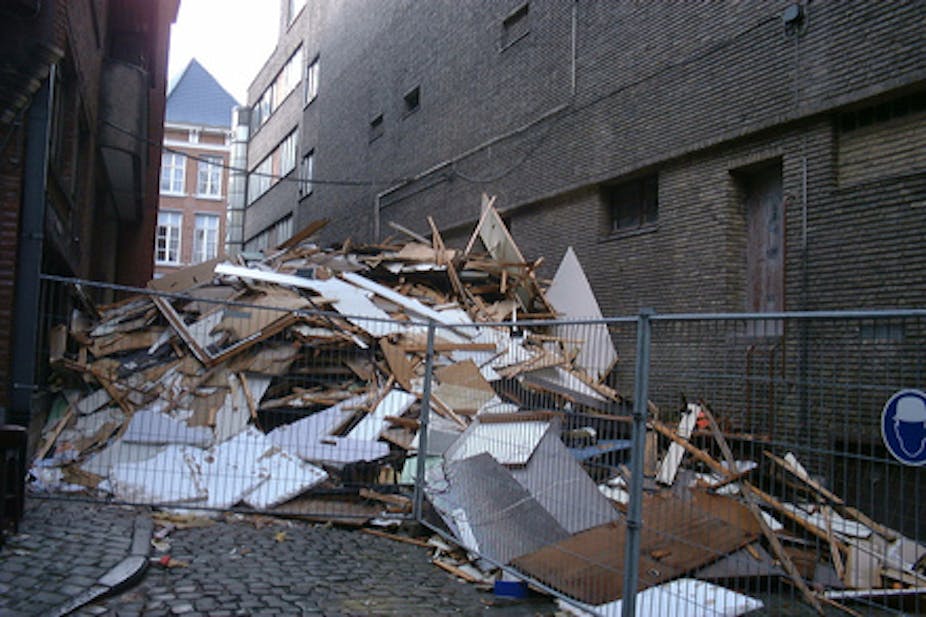Australia is one of the ten worst offenders in the OECD when it comes to generating solid waste. The construction industry is a leading contributor, throwing out a third of our gross national pile of (potentially reusable) junk.
In 2001 the Department of Environmental Heritage identified Australia as one of the highest producers of solid waste. More recently, the Productivity Commission found that the Australian recycling rate of 35 per cent was much lower than other OECD countries. For example, Austria, Belgium, the Netherlands and Germany recycle 61 per cent, 60 per cent, 56 per cent and 56 per cent of their waste respectively.
In 2006-2007, the construction and demolition sector accounted for more than a third of Australia’s 43.8 million tonnes of waste. Approximately 43 per cent of construction and demolition waste (81 per cent of which is building rubble) went to landfill.
The industry has been slow to embrace the new paradigms of environmental sustainability. A 2003 survey of the top 100 companies found that the construction and building materials sector was one of the worst at environmental and sustainability accounting. Only 9 per cent of construction companies surveyed produced separate non-financial reports; the industry average was 23 per cent.
Being eco-efficient doesn’t just minimise waste. Construction companies stand to gain a lot from applying these principles in the design, construction and renovation of buildings. Along with significant environmental benefits, eco-efficiency has social and health benefits for the general public.
Perhaps most compellingly for the industry itself, there are financial advantages associated with sustainability and from delivering buildings and the services they provide more efficiently and with less cost.
The first and most obvious avenue to waste reduction involves a focus on the practical processes of building procurement to reduce waste and increase resource and energy efficiency. For example, in relation to improved application of eco-efficiency principles in the design and life-cycle of building construction, there is significant untapped potential for reducing the environmental ‘footprint’ of buildings by reusing and recycling building materials. Less waste goes to landfill and fewer resources are used.
Using waste from old buildings to construct new buildings and retrofit existing buildings reduces the need to create and transport new materials and products. Manufacture and transport of materials is a significant part of the life-cycle energy consumption of buildings: reducing this reduces energy, greenhouse gas emissions and the building’s carbon footprint.
Secondly, the industry needs to make a “cultural shift” towards ecological sustainability through a reconceptualization of waste as resource (including waste from outside the industry) and a focus on waste minimisation and zero waste practices throughout the life-cycle of building procurement. The culture and behaviour of procurement teams (including financiers and legal advisers, clients, architects, designers, planners, engineers, site operatives, facility managers, construction workers, contractors and subcontractors) can affect waste management practices, including the use of recycled materials. Adequate education, training, information and support structures within the industry could help cultures and behaviours to change.
However, if clients are unaware of the benefits of reused products, or have negative perceptions of recycling, this will in turn affect the behaviours of construction and procurement teams. Therefore, efforts aimed at cultural change must focus not only on procurement teams, but also on clients and the general public.
A third approach would be legally enforcing adoption of ‘zero-waste’ practices in the construction industry. Planning and regulatory requirements need updating. For example, the current Building Code of Australia does not encourage the use of recycled building materials. Introducing and/or increasing landfill levies, taxes and reuse subsidies could help improve recycling and minimise waste. Mandating sorting bins for recycling on construction sites, perhaps backed by government funding or provision, would be another important step.
The drive for legislative change is supported by studies which have found that there is not enough pressure on construction firms to create behavioural change. While in the past, legal commitments have mainly been allocated to contractors, research suggests that compulsory measures are necessary to ensure that all project stakeholders play an active role and share commitments to waste control and reduction.
The University of South Australia is about to begin a research project with Karlsruhe Institute of Technology in Germany and the Shenzhen University in China, ‘Reconsidering Sustainable Building and Design: A Cultural Change Approach’. The project will explore these above issues in detail and develop a best practice model for industry. The research aims to develop a clear pathway to take building procurement teams from present levels of knowledge and practice, towards international best practice and total waste elimination. The project is seeking collaborators for consultation and research (see author’s profile for more information).
Recent climate disasters in Australia and the collapse of the US sub-prime housing market, which spurred the Global Financial Crisis, warn that society must pay sufficient attention to issues of social, environmental and economic sustainability or pay the price. The construction industry needs to adapt, and to play its part in driving this necessary cultural shift.
The industry has already shown that it is capable of embracing change. The area of Occupational Health and Safety has experienced significant improvement in recent years with many construction companies making safety a high priority.
Further change has been embraced to avoid adversarial relationships and a poor contractual culture, which has resulted in improvements in relation to the effectiveness and competitiveness of the industry.
The construction industry has tackled serious problems with its operations and confronted community perceptions in the past. The industry now needs to utilise this ability to foster change to improve sustainability through eco-efficient building and design incorporating zero waste practices.
Aided by research in the area, the construction industry could lead the way to a more sustainable and eco-efficient future for us all.
This article was also co-authored by Professor Frank Schultmann at the Institute for Industrial Production at the Karlsruhe Institute of Technology, Germany, and Professor Jiayuan Wang, the Deputy Head of the College of Civil engineering at Shenzhen University, China.


